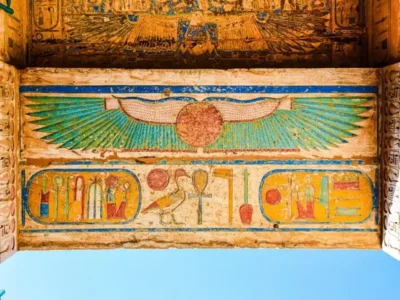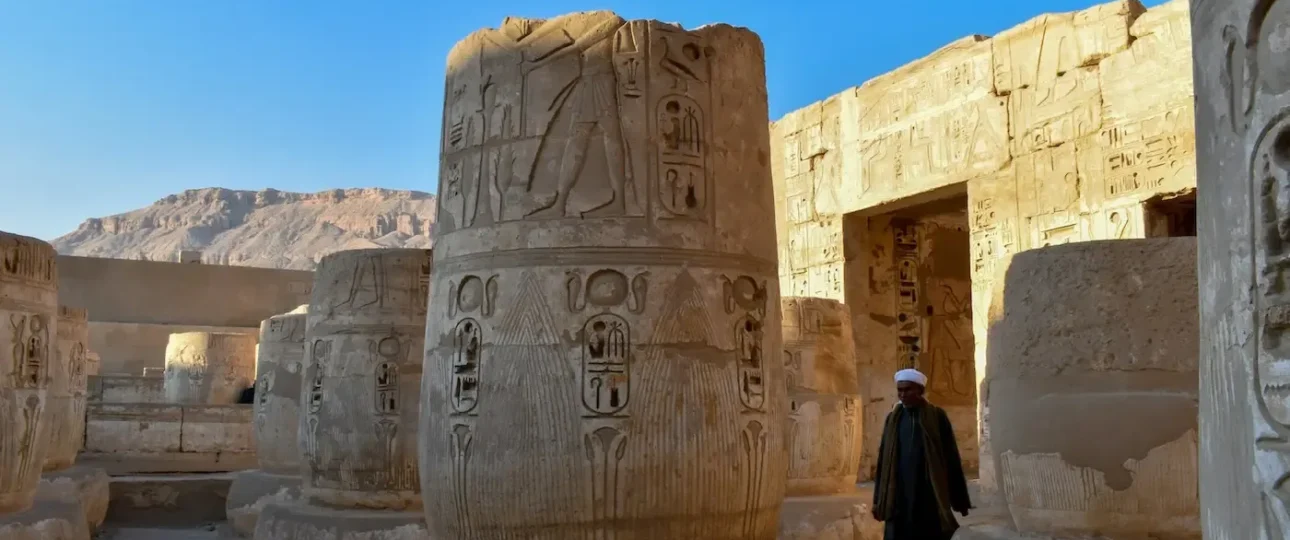Surprising Facts About Habu Temple in Egypt
Medinet Habu, also known as the Mortuary Temple of Ramesses III, stands as a significant structure from ancient Egypt. The temple offers a deep connection to Egypt’s past by showcasing extensive carvings and inscriptions that record various state activities and religious practices. The text below presents a structured analysis of the temple’s features, including its historical background and the many roles it played in the New Kingdom. Each section contributes to a comprehensive picture of how this monument continues to influence our understanding of ancient Egyptian governance and societal norms.
Historical Overview of Medinet Habu
Historical Significance and Origins
Medinet Habu holds a vital position in Egypt’s past as a monument that reflects both religious dedication and state ideology. The site, formerly known by a different name in antiquity, has long been recognized as an important religious area where early Egyptian beliefs were shaped. It has served as a central point for recording the intertwined roles of the divine and the ruler, a connection that remains clear through its inscriptions and reliefs.
The temple’s location on the West Bank of Luxor provided a strategic and symbolic setting, contributing to its long-standing significance. Early records indicate that the area was regarded as a place of deep spiritual importance even before the temple was constructed. The combination of religious rituals and state affairs at this site illustrates how the ancient Egyptians integrated their governance with divine principles, creating a lasting monument that continues to inform modern scholarly research.
Ramesses III and His Reign
Ramesses III is remembered for his efforts to consolidate power during a period of significant challenges. His reign, marked by military campaigns and state reforms, is depicted through a series of detailed reliefs on the temple walls. These inscriptions highlight his leadership and the administrative measures he implemented to secure Egypt during turbulent times. The narratives carved into the stone emphasize both his authority and the extensive organization required to manage the state.
During his time in power, Ramesses III successfully defended the realm against various threats, an achievement recorded in the temple’s artistic programs. The temple stands as a testament to his rule, offering visual and textual evidence of the complex military and administrative strategies he employed. This historical documentation provides modern researchers with valuable insights into the nature of power and governance in ancient Egypt.
Architectural Overview
 Design Principles and Construction
Design Principles and Construction
The architectural design of Medinet Habu follows the established traditions of the New Kingdom while also displaying unique features that set it apart. The layout is organized along a central axis, directing visitors from a fortified entry point through a series of increasingly restricted spaces. This deliberate arrangement of spaces was intended to reflect the gradual progression from public ceremonies to more intimate and sacred rituals. The construction itself is a study in careful planning and skilled workmanship, indicative of the advanced state of engineering at the time.
The temple was built to serve multiple functions, combining elements of state administration, religious ritual, and defense. Each architectural detail—from the imposing entrance to the series of inner sanctuaries—was crafted with precision. This structure not only served as a center for state functions but also as a repository of the social and religious values of its era. The design principles used in the temple remain a subject of study for those interested in the evolution of architectural practices in ancient civilizations.
Structural Features and Relief Carvings
Spanning a considerable length, the main temple structure is organized into several distinct sections, each with its own purpose and design. The complex includes multiple courtyards, halls, and inner rooms that served varied functions in the religious and administrative life of the state. Extensive wall surfaces were decorated with relief carvings that record military events, religious rituals, and state ceremonies. These carvings are an important resource for scholars, as they provide a wealth of information about the era’s artistic conventions and state ideology.
The reliefs themselves are characterized by a high level of detail and precision, reflecting the skill of the craftsmen who worked on the temple. Each carved panel serves as a narrative device, chronicling the achievements of the pharaoh and the rituals that reinforced his authority. The extensive decoration of the walls creates a visual record that has allowed historians to reconstruct aspects of the state’s military strategies and religious practices. The combined architectural and artistic elements make the temple a rich repository of ancient Egyptian history.
Military Commemorations
Reliefs Depicting Conflicts
The outer walls of the temple feature extensive carvings that record various military campaigns. These depictions illustrate the conflicts faced by Egypt, including battles against formidable foes. Each panel provides a detailed account of both land and naval confrontations, serving as a visual document of the strategies and techniques employed during these encounters. The reliefs have become an important resource for understanding the military history of the period, presenting evidence of both the challenges and triumphs of the state.
The detailed representation of combat scenes includes figures in action, along with symbolic elements that reinforce the strength and authority of the ruler. The artistic renderings capture the intensity of battle and the disciplined formations of the troops. By studying these images, researchers gain insight into the organization of the military and the methods used to secure the realm. The carvings continue to serve as a valuable record, offering a window into the ancient strategies that defined a critical period in Egypt’s history.
Military Symbolism in Temple Design
The design of the temple incorporates elements that reflect the dual role of the ruler as both a divine figure and a military leader. The defensive features built into the structure, such as the fortified enclosure and the specially designed entrance, serve as a constant reminder of the state’s preparedness in times of conflict. These architectural choices were deliberate, intended to communicate a strong message of security and authority. They reinforce the idea that the ruler was not only a spiritual guide but also a protector of the nation.
The integration of military symbolism into the design of the temple underscores the importance of state security in ancient Egypt. Every element, from the arrangement of spaces to the depiction of combat in the reliefs, was crafted to emphasize the power and control exercised by the ruler. This fusion of statecraft and religious practice provided a comprehensive visual narrative that celebrated the achievements of the pharaoh. It remains a key focus for researchers studying the methods used to project authority in a complex society.
Administrative and Economic Functions
Support Structures and Record Keeping
Medinet Habu was designed to function beyond its role as a temple for worship. It also served as an administrative center that played a crucial role in the management of state resources. Various storehouses and record-keeping facilities were integrated into the complex, ensuring that agricultural products, luxury items, and ritual supplies were meticulously accounted for. These support structures formed the backbone of a sophisticated administrative system that helped maintain economic stability during challenging times.
The records preserved in the temple, written on papyrus and ostraca, provide detailed insights into the operational aspects of state administration. These documents reveal the methods used to manage labor, distribute resources, and oversee the vast economic network that supported the temple’s functions. By analyzing these records, researchers are able to reconstruct the administrative framework that underpinned ancient Egyptian society. The integration of these economic functions with the religious aspects of the temple demonstrates the multifaceted role the complex played in ancient state affairs.
Integration of Economic and Religious Roles
The design of the temple reflects a close interconnection between economic management and religious practices. The state’s economic activities were not separate from its spiritual duties; rather, they were woven together into a single institutional framework. The temple complex functioned as a center for both ritual observance and economic administration, where officials and priests worked side by side to maintain state stability. This dual role is evident in the layout of the complex and the organization of its various support structures.

This integration allowed the temple to serve as a hub of social activity, influencing not only religious observances but also the distribution of wealth and resources. The administrative buildings and storehouses ensured that the complex could support large-scale operations, including the funding of military campaigns and the organization of public ceremonies. The seamless blend of economic and religious roles provided a model of governance that has intrigued modern researchers. The structure of the temple continues to offer insights into the ways in which ancient societies managed both spiritual and material needs.
Royal Functions and Political Intrigue
The Royal Palace and Ritual Practices
Adjacent to the main temple structure, the remains of a royal palace indicate the significance of the site in state affairs. The palace areas provided essential facilities for the ruler during ceremonial events and state functions. These spaces were designed to accommodate the personal needs of the pharaoh while ensuring that he could participate in rituals with the appropriate level of formality. The close connection between the palace and the temple highlights the dual responsibilities of the ruler in both governance and spiritual leadership.
The architectural layout of the palace areas reveals a thoughtful approach to balancing public and private functions. Private chambers, reception halls, and administrative areas were all arranged to facilitate efficient movement and interaction during important events. The design of these spaces underscores the complexity of royal duties, where personal, political, and spiritual obligations were intertwined. Researchers continue to study these sections to gain a better understanding of the state’s administrative practices and the role of the ruler in maintaining order and stability.
Conspiracies and Royal Downfall
Medinet Habu also bears witness to the darker aspects of royal politics. The temple’s inscriptions record the internal conflicts that eventually led to the downfall of a prominent ruler. Documents and carved scenes detail a conspiracy that involved members of the inner circle, reflecting the intense political rivalries that sometimes erupted in ancient Egypt. This record of internal strife offers a valuable perspective on the challenges of maintaining power and control in a complex society.
The narrative of royal conspiracies adds a layer of complexity to the temple’s overall story. The detailed depictions of internal conflict and subsequent punishment serve as a reminder of the precarious nature of power. Such accounts provide modern researchers with crucial insights into the mechanisms of state control and the methods used to secure loyalty within the ruling class. The recorded events illustrate that even in a highly organized society, personal ambition and political maneuvering could disrupt the stability of the state.
Modern Research and Preservation Efforts
Excavation History and Ongoing Studies
The systematic study of Medinet Habu began in the early decades of the last century, marking a turning point in the understanding of ancient statecraft. Early excavations laid the foundation for modern research by clearing debris, stabilizing structures, and documenting the temple’s detailed inscriptions and carvings. These initial efforts have since been built upon by successive generations of researchers who continue to apply advanced techniques and technology to further document and preserve the complex.
Ongoing studies at the temple involve a range of scientific methods that help uncover new details about its construction and use. These projects are focused on monitoring at-risk areas and refining our understanding of the temple’s layered history. The work being done today not only reinforces the importance of the monument but also provides a model for the conservation of similar sites. Researchers remain committed to ensuring that this ancient record remains available for future study and educational purposes.
Preservation and Future Perspectives
Efforts to preserve Medinet Habu are crucial for maintaining the integrity of one of Egypt’s significant state monuments. Modern conservation techniques are applied alongside traditional methods to stabilize the structure while carefully maintaining its original details. This ongoing work ensures that the temple remains an accessible source of information for researchers and enthusiasts of ancient Egyptian governance and state affairs.
The future of the temple is closely tied to continuous research and the development of innovative preservation strategies. As new methods are tested and implemented, there is a growing emphasis on a forward-thinking approach to conservation. This commitment not only safeguards the monument for future generations but also enriches our understanding of the strategies and practices that supported one of history’s most complex societies. The combined efforts in research and preservation serve as a testament to the enduring importance of Medinet Habu in the study of ancient statecraft.
Preservation efforts and modern research continue to safeguard Medinet Habu, ensuring that this extraordinary monument remains a valuable source of knowledge and inspiration for generations to come. Its inscriptions, architecture, and layered history make it one of the most impressive sites of ancient Egypt.
For travelers eager to experience Medinet Habu alongside other iconic landmarks of Luxor and Upper Egypt, a Nile cruise
offers the perfect journey—combining the beauty of the river with the timeless wonders of pharaonic history.


 Design Principles and Construction
Design Principles and Construction